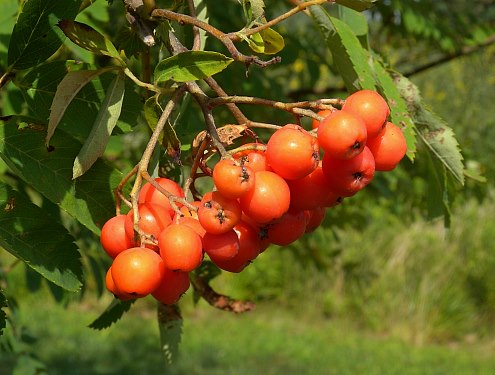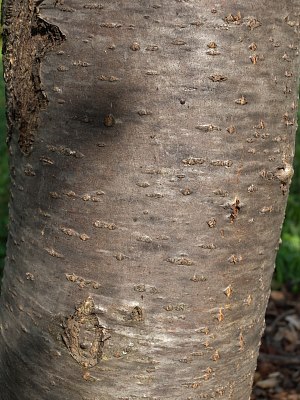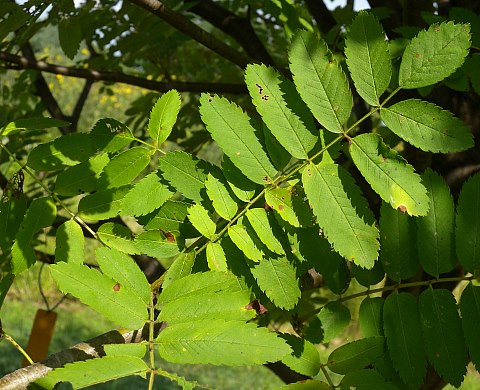
Flat-headed panicles of white flowers are produced occasionally from the axils of the leaves; these panicles are 3-6" across and erect to slightly nodding. The peduncle and pedicels of each panicle are light green and pubescent; later they become light brown or yellowish brown when the fruit matures. Individual flowers are 1/3" (8 mm.) across, consisting of 5 spreading white petals, a short green calyx with 5 teeth, an inferior ovary with 3-4 styles, and 15-20 white stamens. The blooming period occurs from late spring to mid-summer. The flowers are usually mildly fragrant. Fertile flowers are replaced by small fleshy fruits called 'pomes.' At maturity, individual pomes are about 1/3" (8 mm.) across, globoid or slightly subgloboid, bright orange to red, and usually 2-seeded. These pomes have a bitter flavor. The root system is woody and branching. This tree reproduces by reseeding itself.

Cultivation: The preference is full to partial sun, moist to dry-mesic conditions, and cool to warm summer temperatures. The soil can contain clay-loam, loam, peat, or rocky soil; its pH should be somewhat acidic. This tree has excellent winter hardiness; it develops slowly and is relatively short-lived.
Range & Habitat: European Mountain Ash is a non-native tree that has naturalized in NE Illinois (see Distribution Map). Outside of cultivation, it is uncommon. This species was introduced to North America from Eurasia as an ornamental landscape tree. Within the state, habitats consist of swamps, bogs, fens, and roadsides. In Eurasia, this tree is often found in mountainous areas with acidic bedrock (e.g., granite).
Faunal Associations: Very little information is available about flower-visiting insects for Mountain Ash trees (Sorbus spp.) in North America, including for this tree, European Mountain Ash (Sorbus aucuparia). In Europe, the flower-visiting insects consist primarily of flies, bees, and beetles (Trees for Life, accessed 2024). Both nectar and pollen are available as floral rewards. Other insects feed destructively on Mountain Ash trees, especially armored scales and larvae of moths. These insects include larvae of the Round-headed Appletree Borer (Saperda candida), Rose Chafer (Macrodactylus subspinosus), Apple-grass Aphid (Rhopalosiphum oxyacanthae), Scurfy Bark Scale (Chionaspis furfura), larvae of the Mountain Ash Sawfly (Pristiphora geniculatus), larvae of the Apple Seed Chalcid (Torymus varians), larvae of the Apple Fruit Moth (Argyresthia conjugella), larvae of the Apple Blotch Leafminer Moth (Phyllonorycter crataegella), larvae of the Woody Underwing (Catocala grynea), and larvae of several dagger moths (Acronicta spp.). The Insect Table has a more complete list of this group of insects. Among vertebrate animals, the fruits of Mountain Ash trees are eaten by several kinds of birds. This includes the Cedar Waxwing, Evening Grosbeak, Baltimore Oriole, Gray Catbird, Ruffed Grouse, Red-headed Woodpecker, White-breasted Nuthatch, Wood Thrush, and American Robin. The Bird Table provides a more complete list of these species. These birds spread the seeds of the fruits to new areas. The American Black Bear also feeds on the fruits, while the American Moose browses on the foliage and twigs of these trees (Romain et al., 2013; Mosnier et al., 2008; Martin et al., 1951/1961).
Photographic Location: The Arboretum at the University of Illinois in Urbana, Illinois.

Comments: European Mountain Ash is rather variable across its range and several subspecies have been described. The typical subspecies, Sorbus aucuparia aucuparia, is a small tree with pubescent shoots and leaves, while another subspecies, Sorbus aucuparia sibirica, is a small tree with glabrous shoots and leaves. Other subspecies, which are usually found in Alpine or northern boreal areas, are short multi-stemmed shrubs; these latter subspecies are rarely cultivated in North America. Two native species, Sorbus americana (American Mountain Ash) and Sorbus decora (Showy Mountain Ash), have been found in northern Illinois, where they are quite rare. These native species differ from European Mountain Ash by having larger leaflets (2-3½") with more elongated tips, and their young shoots and buds are glabrous, rather than pubescent or hairy. In spite of their common names, these species are not closely related to true Ashes (Fraxinus spp.), with whom they share superficially similar compound leaves. Another common name of Sorbus aucuparia is the Rowan Tree.